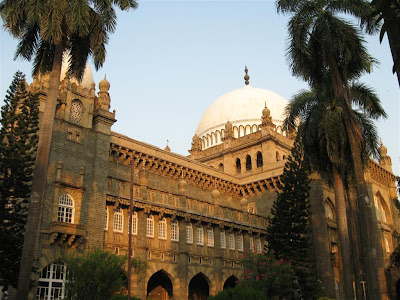 The Mumbai sky as seen this morning at 0700hrs.
The Mumbai sky as seen this morning at 0700hrs.To see the skies around the world please click Here
 A sunrise in the Bandra Kurla Complex in Mumbai.
A sunrise in the Bandra Kurla Complex in Mumbai.
 The National Stock Exchange building in the Bandra Kurla Complex - the upcoming Business district of Mumbai.
The National Stock Exchange building in the Bandra Kurla Complex - the upcoming Business district of Mumbai. Barely a stone's throw from the Gateway of India is the CHHATRAPATI SHIVAJI MAHARAJ VASTU SANGRAHALAYA (Formerly known as: THE PRINCE OF WALES MUSEUM OF WESTERN INDIA), a magnificent structure, built in a confluence of Gothic and Moorish styles, and crowned by a sparkling white dome.
Barely a stone's throw from the Gateway of India is the CHHATRAPATI SHIVAJI MAHARAJ VASTU SANGRAHALAYA (Formerly known as: THE PRINCE OF WALES MUSEUM OF WESTERN INDIA), a magnificent structure, built in a confluence of Gothic and Moorish styles, and crowned by a sparkling white dome. Heres another moth. An amazing looking critter!
Heres another moth. An amazing looking critter!
Rangoli is one of the most popular art forms in India. It is a form of sandpainting decoration that uses finely ground white powder and colours, and is used commonly outside homes in India. Rangoli can be wall art as well as floor art. The term rangoli is derived from words rang (colour) and aavalli ('coloured creepers' or 'row of colours'). The picture above is a Rangoli made at the entrances to one of the offices in Mumbai where the Puja of Goddess Durga was being held.
In India, red powder called Gulal is flung into the air during prcessions to mark celebrations. Red is the color of festivity, vibrancy, energy and love.
For more Ruby Red sensations click here
 This guy is sure tiny. Caught him strolling around near the window!
This guy is sure tiny. Caught him strolling around near the window!.jpg) Khauttays are rice cakes prepared by wrapping the batter in cones/cups of woven Jackfruit leaves and steaming them like idlis
Khauttays are rice cakes prepared by wrapping the batter in cones/cups of woven Jackfruit leaves and steaming them like idlis
The taste and aroma is unique and wonderful! They are prepared only on special occasions. They are the original form of idlis which are steamed in steel containers.